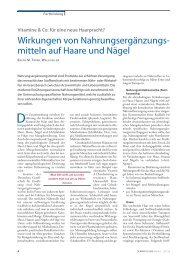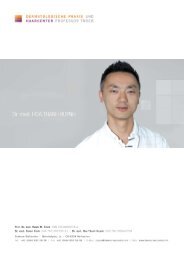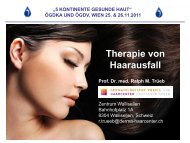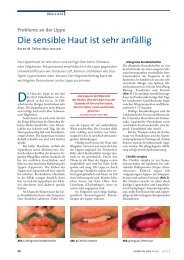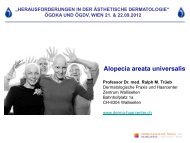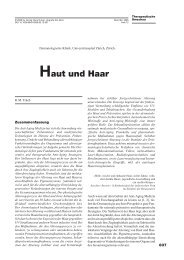EADV Fostering Training Course in Hair & Scalp
EADV Fostering Training Course in Hair & Scalp
EADV Fostering Training Course in Hair & Scalp
You also want an ePaper? Increase the reach of your titles
YUMPU automatically turns print PDFs into web optimized ePapers that Google loves.
<strong>EADV</strong> <strong>Foster<strong>in</strong>g</strong> <strong>Tra<strong>in</strong><strong>in</strong>g</strong> <strong>Course</strong> <strong>in</strong> <strong>Hair</strong> & <strong>Scalp</strong><br />
Bologna, Italy - 18-20 November 2011<br />
<strong>Hair</strong> Cosmetics<br />
Professor Ralph M. Trüeb, M.D.<br />
Center for Dermatology and <strong>Hair</strong> Diseases<br />
Zentrum Wallisellen<br />
Bahnhofplatz 1a<br />
CH-8304 Wallisellen (Zurich)<br />
Switzerland
Significance of <strong>Hair</strong><br />
<strong>Hair</strong> care, color and style play an important role <strong>in</strong><br />
people’s physical appearance and self-perception.<br />
<strong>Hair</strong> def<strong>in</strong>es an <strong>in</strong>dividual’s:<br />
• gender<br />
• age<br />
• sexual attitude<br />
• social status.<br />
There are no significant differences <strong>in</strong> the number of<br />
hair follicles between men and women, or between<br />
different races.<br />
Differences <strong>in</strong> the appearance of hair are due to:<br />
• type of hair produced by a follicle<br />
• type of hair care and cosmetics practiced by the<br />
<strong>in</strong>dividual.
Relevant Criteria for Condition of <strong>Hair</strong><br />
<strong>in</strong> Men (Swiss Survey)<br />
Criteria: 1<br />
(unimportant)<br />
Wellgroomed<br />
appearance<br />
Good hairstyle<br />
Appropriate<br />
hair-style<br />
<strong>Hair</strong> growth:<br />
• Length<br />
• Density<br />
6 %<br />
13 %<br />
19 %<br />
27 %<br />
35 %<br />
2 3 4 5<br />
(very<br />
important)<br />
3 %<br />
7 %<br />
9 %<br />
17 %<br />
19 %<br />
12 %<br />
21 %<br />
22 %<br />
24 %<br />
21 %<br />
From: Trüeb RM et al. Schw Rundsch Med 2001;90:241-248<br />
24 %<br />
31 %<br />
24 %<br />
9 %<br />
13 %<br />
55 %<br />
28 %<br />
26 %<br />
13 %<br />
12 %<br />
Mean<br />
4.2<br />
3.5<br />
3.3<br />
2.7<br />
2.5
Condition of the <strong>Hair</strong> Fibre<br />
• Hereditary and ethnic factors<br />
• Age and sex<br />
• Nutritional and overall health status<br />
• Condition of the scalp<br />
• <strong>Hair</strong> length<br />
• <strong>Hair</strong> care and styl<strong>in</strong>g habits<br />
• External factors and hair damage<br />
<strong>in</strong>cl. from cosmetic hair treatments
<strong>Hair</strong> Weather<strong>in</strong>g: <strong>Hair</strong> Damage Result<strong>in</strong>g from External Factors<br />
„Wear and tear“ from environment and cosmetic procedures that ma<strong>in</strong>ly<br />
affects the free end of the grow<strong>in</strong>g hair fiber:<br />
• Friction damage from comb<strong>in</strong>g and brush<strong>in</strong>g<br />
• Damage from excessive heat „blown“ or from<br />
curl<strong>in</strong>g irons<br />
• Structural and chemical damage from<br />
chemical treatment of hair, i.e., bleach<strong>in</strong>g,<br />
color<strong>in</strong>g, perm<strong>in</strong>g, and straighten<strong>in</strong>g<br />
• Effects of UVR (photoag<strong>in</strong>g)
<strong>Hair</strong> Weather<strong>in</strong>g<br />
Alterations <strong>in</strong> the ultrastructure, physical and chemical properties of the hair fiber:<br />
• Mechanical abrasion of the cuticle<br />
• Damage of the hair cortex with alterations of visco-elastic properties and<br />
tensile strength of the hair fibre<br />
• Depletion of specific am<strong>in</strong>o acids: meth<strong>in</strong>on<strong>in</strong>e (- 50%), tryptophane (- 50%)<br />
cyst<strong>in</strong>e (- 20%), histid<strong>in</strong>e (- 20%), tyros<strong>in</strong>e (- 15%), lys<strong>in</strong>e (- 10%),<br />
Gummer and Schiel. 4th Intercont<strong>in</strong>ental <strong>Hair</strong> Research Societies Meet<strong>in</strong>g, Berl<strong>in</strong>, June 17-19, 2004<br />
Trichorrhexis nodosa
Effect of UVR on <strong>Hair</strong><br />
Photodamage is a common cause of poor hair condition<br />
(and underscores the significance of photoprotection)<br />
Effects of UVR on hair (color, structure, and growth):<br />
• Sunlight damages both hair color and hair structure (hair photoag<strong>in</strong>g)<br />
• Gray hair is more susceptible to UV-<strong>in</strong>duced damage than pigmented hair<br />
• acute telogen effluvium<br />
Hot<strong>in</strong>g et al. J Soc Cosmet Chem, 46, 85-99, 1995<br />
Camacho et al. Arch Dermatol 1996;132:1398-1399<br />
• production of porphyr<strong>in</strong>s by Propionibacterium sp. <strong>in</strong> the pilosebaceous duct, with<br />
photoactivation lead<strong>in</strong>g to oxidative tissue <strong>in</strong>jury and follicular micro<strong>in</strong>flammation<br />
Piérard-Franchimont et al. Exog Dermatol 2002;1:203-206<br />
• direct physicochemical stress from UVR to kerat<strong>in</strong>ocytes with production of radical oxygen<br />
species and nitric oxide and release of pro<strong>in</strong>flammatory cytok<strong>in</strong>es, eventually lead<strong>in</strong>g to<br />
<strong>in</strong>jury of the putative site of follicular stem cells <strong>in</strong> the superficial portion of the hair<br />
follicle<br />
Mahé et al. Int J Dermatol 2000;39:576-584
Cosmetic <strong>Hair</strong> Treatment:<br />
• Cleans<strong>in</strong>g hair<br />
• Condition<strong>in</strong>g hair<br />
• Styl<strong>in</strong>g hair<br />
• Chang<strong>in</strong>g hair<br />
colour/colour<strong>in</strong>g hair<br />
• Perm<strong>in</strong>g hair<br />
Trüeb. J Invest Dermatol Symp Proc 2005;10:289-292<br />
Science of <strong>Hair</strong>-Care<br />
„Cosmeceutical“<br />
• Promot<strong>in</strong>g hair<br />
growth?<br />
• Prevent<strong>in</strong>g hair<br />
ag<strong>in</strong>g?<br />
Medic<strong>in</strong>al Treament of<br />
Specific Problems<br />
Relat<strong>in</strong>g to Superficial<br />
Condition of <strong>Scalp</strong>:<br />
• Dandruff (pityriasis)<br />
• Itch<strong>in</strong>ess (pruritus)<br />
• <strong>Hair</strong> loss (alopecia)<br />
• Specific dermatologic<br />
conditions of the scalp
<strong>Hair</strong> Cosmetics<br />
<strong>Hair</strong> Shampoos: To remove sebum and<br />
environmental dirt without decreas<strong>in</strong>g cosmetic<br />
appearance of hair.<br />
<strong>Hair</strong> Conditioners: To improve hair manageability,<br />
decrease hair static electricity, add luster, and<br />
enhance styl<strong>in</strong>g ease.<br />
<strong>Hair</strong> Styl<strong>in</strong>g Aids: To ma<strong>in</strong>ta<strong>in</strong> hair <strong>in</strong> fashionable<br />
arrangement while improv<strong>in</strong>g the quality of hair fibers.<br />
<strong>Hair</strong> Dyes: To lighten or darken hair color while<br />
cover<strong>in</strong>g gray hair<br />
Permanent <strong>Hair</strong> Wav<strong>in</strong>g/Straighten<strong>in</strong>g: To<br />
reposition hair kerat<strong>in</strong> disulfide bonds <strong>in</strong> a new curly<br />
or straight position
<strong>Hair</strong> Shampoos<br />
The art of shampoo formulation is select<strong>in</strong>g the right detergent<br />
comb<strong>in</strong>ation to cleanse the scalp and beautify the hair simultaneously.<br />
Term from H<strong>in</strong>di câpnâ, „to press or knead“<br />
Most common form of cosmetic hair treatment. 50% of total<br />
units sold <strong>in</strong> hair products sector<br />
Today‘s consumer expectations (multifunctionality):<br />
• Cosmetic benefit<br />
• Tailored to variations associated with :<br />
- age<br />
- hair quality<br />
- hair care habit<br />
- problems relat<strong>in</strong>g to the superficial condition of scalp,<br />
i.e. greas<strong>in</strong>ess, dryness, itch<strong>in</strong>ess, flak<strong>in</strong>g (dandruff)
Modification of<br />
surfactant activity<br />
Amphoterics<br />
Foam stabilizers<br />
Humefactants<br />
Thickeners<br />
Cleans<strong>in</strong>g agents<br />
Detergency<br />
Anionics<br />
Nonionics<br />
+<br />
Additives<br />
Product stability Product comfort<br />
Preservatives<br />
Chelat<strong>in</strong>g agents<br />
UV absorbers<br />
Buffer<strong>in</strong>g agents<br />
Emulsifiers<br />
Solvents<br />
Shampoo Ingredients<br />
Conditioners<br />
Special care<br />
<strong>in</strong>gredients<br />
Treatment of specific problems related to the<br />
superficial condition of the scalp<br />
Cationics<br />
Cationic polymers<br />
Hydrolized prote<strong>in</strong>s<br />
Silicones<br />
Waxes<br />
Lecith<strong>in</strong>e<br />
Panthenol<br />
Ceramide<br />
Fragrances<br />
Colorants<br />
Pearlescents<br />
Opacifiers<br />
Herb extracts<br />
Crude coal tar<br />
Selenium disulfide<br />
Z<strong>in</strong>k pyrithione<br />
Octopirox<br />
Ketoconazole
Cleans<strong>in</strong>g Agents<br />
Lipophilic fatty cha<strong>in</strong> Hydrophilic end<br />
Surfactant type:<br />
(polar group charge)<br />
Anionics<br />
(negative)<br />
Cationics<br />
(positive)<br />
Amphoterics<br />
(both)<br />
Nonionics<br />
(none)<br />
-<br />
+<br />
+<br />
-<br />
0 0 0<br />
There are four categories of shampoo detergents<br />
with different hair cleans<strong>in</strong>g and condition<strong>in</strong>g qualities,<br />
comb<strong>in</strong>ed to yield the f<strong>in</strong>al shampoo characteristics<br />
Chemical class/examples: Characteristics: Purpose:<br />
Lauryl sulfates, laureth<br />
sulfates, sarcos<strong>in</strong>es,<br />
sulfosucc<strong>in</strong>ates<br />
Long cha<strong>in</strong> am<strong>in</strong>o esters,<br />
ammonioesters<br />
Beta<strong>in</strong>es, sulta<strong>in</strong>es,<br />
imidazol<strong>in</strong>ium derivatives<br />
Polyoxethylene fatty<br />
alcohols, polyoxyethylene<br />
sorbitol esters,<br />
alkanolamides<br />
Deep cleans<strong>in</strong>g, may<br />
leave hair harsh<br />
Poor cleans<strong>in</strong>g, poor<br />
lather, impart softness<br />
and manageability<br />
Nonirritat<strong>in</strong>g to eyes,<br />
mild cleans<strong>in</strong>g, impart<br />
manageability<br />
Mildest cleans<strong>in</strong>g,<br />
impart manageability<br />
Cleans<strong>in</strong>g<br />
Condition<strong>in</strong>g<br />
Additive for<br />
modification of<br />
surfactant activity<br />
Cleans<strong>in</strong>g
Condition<strong>in</strong>g Agents<br />
Sebum is the ideal hair conditioner. Excessive removal of sebum <strong>in</strong> the course<br />
of wash<strong>in</strong>g the hair and scalp created the need for synthetic sebum-like<br />
substances that attempt to supply hair with the positive attributes of sebum while<br />
avoid<strong>in</strong>g the greasy appearance of excessive sebum and dirty hair.<br />
Aim of conditioners:<br />
• Impart softness<br />
• Increase luster and gloss<br />
• Reduce fly-away<br />
• Enhance disentagl<strong>in</strong>g facility<br />
• Alleviate defects related to certa<strong>in</strong> types of<br />
hair and hair treatments (hair weather<strong>in</strong>g)<br />
Products:<br />
• Shampoos for dry or damaged hair<br />
• Condition<strong>in</strong>g („2-<strong>in</strong>-1“) shampoos<br />
• <strong>Hair</strong> conditioners (liquids, creams, pastes, gels)
Condition<strong>in</strong>g Agents<br />
<strong>Hair</strong> conditoner<br />
category<br />
Fatty <strong>in</strong>gredients Fatty alcohols, lanol<strong>in</strong><br />
derivatives, oils,<br />
waxes, lecith<strong>in</strong>s<br />
Cationic detergent<br />
and film formers<br />
Primary <strong>in</strong>gredient Ma<strong>in</strong> advantage <strong>Hair</strong> groom<strong>in</strong>g benefit<br />
Quaternary<br />
ammonium<br />
compounds („quats“)<br />
Polymers<br />
(polyquaternium)<br />
Prote<strong>in</strong>-conta<strong>in</strong><strong>in</strong>g Hydrolyzed prote<strong>in</strong>s<br />
(kerat<strong>in</strong>, collagen, silk,<br />
wheat, soya)<br />
Silicones Dimethicone,<br />
cycolmethicone,<br />
amodimethicone<br />
Increase hair sh<strong>in</strong>e,<br />
<strong>in</strong>crease hair<br />
manageability<br />
Smooth cuticle,<br />
decrease static<br />
electricity<br />
Fill hair shaft defects,<br />
decrease static<br />
electricity, improve<br />
sh<strong>in</strong>e<br />
Penetrate hair shaft to<br />
m<strong>in</strong>imally <strong>in</strong>crease<br />
strength<br />
Th<strong>in</strong> coat<strong>in</strong>g placed on<br />
hair shaft<br />
Improve appearance of<br />
dry hair<br />
Excellent to restore<br />
damaged, chemically<br />
processed hair<br />
Improve appearance of<br />
dry hair, improve<br />
groom<strong>in</strong>g of coarse,<br />
k<strong>in</strong>ky hair<br />
Temporarily mend<br />
splits<br />
Decrease static<br />
electricity, decrease<br />
comb<strong>in</strong>g friction, add<br />
sh<strong>in</strong>e
Special Care Ingredients<br />
Aim at specific problems relat<strong>in</strong>g to the superficial condition of the scalp:<br />
Dandruff<br />
Greas<strong>in</strong>ess/<br />
Dryness<br />
(seborrhoes/sebostasis)<br />
Diffuse red scalp disease<br />
Itch<strong>in</strong>ess (pruritus)<br />
<strong>Scalp</strong> dysesthesia (trichodynia)<br />
Specific dermatologic<br />
conditions of scalp<br />
<strong>Scalp</strong> excoriations
Dandruff: Pathogenic Triangle<br />
Malassezia<br />
Yeast<br />
Inflammatory<br />
Initiator<br />
Inflammation<br />
Hyperproliferation<br />
Parakeratosis<br />
Sebaceous<br />
Lipids<br />
Sk<strong>in</strong> Surface
Special Care Ingredients<br />
Condition: Effect: Agent:<br />
Dandruff Keratostatic<br />
(slows cell turnover)<br />
Keratolytic<br />
(exfoliant)<br />
Anti-fungal<br />
(Malassezia spp.)<br />
Itch Anti-pruritic<br />
Crude coal tar (MIC: 250 – 5‘000)<br />
Salicylic acid (MIC: > 100)<br />
Colloidal sulfur<br />
Selenium disulfide (MIC: 1.56-3.3)<br />
Z<strong>in</strong>k pyrithione (MIC: 0.78 – 1.66)<br />
Ketoconazole (MIC: 0.1)<br />
Others: Octopirox, Climbazole, Ciclopirox<br />
olam<strong>in</strong>e (available only <strong>in</strong> select regions of<br />
the world)<br />
Menthol<br />
Polidocanol<br />
Dry Humefactant Panthenol<br />
Urea<br />
Greasy Sebosuppressive Crude coal tar
Anti Dandruff Shampoo<br />
Potency <strong>in</strong> terms of MIC‘s is important, but it is not the<br />
sole factor that determ<strong>in</strong>es efficacy.<br />
Other <strong>in</strong>fluential aspects of treatment pharmacology<br />
<strong>in</strong>clude:<br />
• Delivery<br />
• Retention<br />
• Bioavailability<br />
• Mildness<br />
• Aesthetics<br />
Patients are compliant for only 30 seconds: Shampoos<br />
that achieve antimycosis on contact lead to more<br />
successful management of dandruff.<br />
Because dandruff must be controlled through regular<br />
treatment, the cosmetic aspects of shampoo-based<br />
therapy must be acceptable to patients or compliacne will<br />
be compromised.<br />
3 out of 4 women suffer<strong>in</strong>g from dandruff would prefer to<br />
use a medicated shampoo with condition<strong>in</strong>g benefits.
Ag<strong>in</strong>g <strong>Hair</strong><br />
• Loss of follicle rigor, consistent with slow<strong>in</strong>g of other body activities with age<br />
• Senescence of the hair is particularly visible<br />
• Failure to pigment the hair shaft (gray<strong>in</strong>g)<br />
• Decrease <strong>in</strong> rapidity of hair growth<br />
• Reduction <strong>in</strong> the diameter of the hair shaft<br />
• Senescent alopecia is different from androgenetic alopecia<br />
Trüeb RM. Ag<strong>in</strong>g of hair. J Cosmet Dermatol. 2005;4:60-72.<br />
Trüeb RM. Pharmacologic <strong>in</strong>terventions <strong>in</strong> ag<strong>in</strong>g hair. Cl<strong>in</strong> Interv Ag<strong>in</strong>g. 2006;1:121-9.
Cosmetic Treatment for Ag<strong>in</strong>g <strong>Hair</strong><br />
• 8 groom<strong>in</strong>g rules for ma<strong>in</strong>ta<strong>in</strong><strong>in</strong>g good look<strong>in</strong>g hair<br />
• Special shampoo selection for ag<strong>in</strong>g hair<br />
• Conditioner use<br />
• Use of hair styl<strong>in</strong>g aids<br />
• <strong>Hair</strong> photoprotection
Eight Groom<strong>in</strong>g Rules for Ma<strong>in</strong>ta<strong>in</strong><strong>in</strong>g Good Look<strong>in</strong>g <strong>Hair</strong><br />
• Manipulate hair as little as possible<br />
• Comb hair gently<br />
• Avoid comb<strong>in</strong>g wet hair<br />
• Avoid high temperature appliances<br />
• Select a vented ball tip styl<strong>in</strong>g brush<br />
• Avoid scratch<strong>in</strong>g of hair and scalp<br />
• Cut away split ends<br />
• Preferably wear short hair style
Special Shampoo Selection for Ag<strong>in</strong>g <strong>Hair</strong><br />
Primary cleanser:<br />
• Anionic, usually a lauryl sulfate, <strong>in</strong> comb<strong>in</strong>ation with<br />
a laureth sulfate<br />
• or a sarcos<strong>in</strong>e for dry hair<br />
• resp. a sulfosucc<strong>in</strong>ate for greasy hair<br />
Secondary cleanser (for mild shampoos):<br />
• Nonionic or amphoteric (<strong>in</strong> baby shampoos)<br />
Shampoo conditioners:<br />
• Mature <strong>in</strong>dividuals should select conditioners<br />
developed for f<strong>in</strong>e hair, preferably:<br />
• silicone (dimethicone)<br />
• panthenol (humefactant)<br />
• hydrolyzed prote<strong>in</strong>s (no build up)<br />
Special „anti-ag<strong>in</strong>g“ <strong>in</strong>gredients (effect?):<br />
• Antioxidants (protect shampoos from oxidation)<br />
• Melaton<strong>in</strong><br />
• „Energizers“ (caffe<strong>in</strong>e, guarana, g<strong>in</strong>gko)<br />
• Others from TCM (heshouwou) or Ayurweda
Adverse Effects from Cosmetic <strong>Hair</strong> Treatment: <strong>Hair</strong> Loss<br />
Women with telogen effluvium often blame hair cosmetics for their hair loss.<br />
Diffuse hair loss associated with the use of<br />
keratostatic anti-dandruff agents has been<br />
discussed <strong>in</strong> the literature.<br />
Grover RW. Diffuse hair loss associated with selenium<br />
(Selsun) sulfide shampoo.<br />
J Am Med Ass 1956;160:1397-1398<br />
Archer et al. Effect of selenium sulfide suspension<br />
on hair roots. J Invest Dermatol 1960;35:65-67<br />
Orentreich et al. Selenium disulfide shampoo.<br />
It’s <strong>in</strong>fluence on hair growth and the follicular cycle. Arch Dermatol 1964;90:76-80<br />
The absence of effects of shampoos on hair loss rates has been demonstrated.<br />
Kullavanijaya et al. Absence of effects of dimethicone- and non-dimethicone-<br />
conta<strong>in</strong><strong>in</strong>g shampoos on daily hair loss rates. J Soc Cosm Chem 1992;43:195-206<br />
Acute diffuse telogen effluvium may follow allergic contact dermatitis of the<br />
scalp to hair dyes.<br />
Tosti et al. Telogen effluvium after allergic contact dermatitis of the scalp.<br />
Arch Dermatol 2001;137:187-190
Hot-Comb Alopecia<br />
Hot-comb alopecia (follicular degeneration syndrome,<br />
central centrifugal scarr<strong>in</strong>g alopecia)<br />
• Well-def<strong>in</strong>ed area of partial hair loss over the top of<br />
the head<br />
• Seen almost exclusively <strong>in</strong> patients of African orig<strong>in</strong><br />
• Presumably related to peculiarities of African hair<br />
anatomy and groom<strong>in</strong>g habits<br />
• Possibly related to excessive use of heat<br />
LoPresti et al. Arch Dermatol 1968;98:234-8<br />
• Adverse effects reported by persons who used a commercial hair-straighten<strong>in</strong>g<br />
product known as the „Rio <strong>Hair</strong> Naturalizer System“ (World Rio Corporation).<br />
Most reported substantial hair loss, with a majority <strong>in</strong>dicat<strong>in</strong>g growth of new hair<br />
that was abnormal <strong>in</strong> both quantity and quality.<br />
Swee et al. A nationwide outbreak of alopecia associated with the use of a<br />
hair-relax<strong>in</strong>g formulation. Arch Dermatol 2000;136:1104-1108
<strong>Hair</strong> Matt<strong>in</strong>g<br />
Rare condition of dramatic onset of<br />
irreversible tangl<strong>in</strong>g of scalp hair.<br />
<strong>Hair</strong> matt<strong>in</strong>g is not a primary hair disorder:<br />
Physical conditions, chemical agents, and<br />
behavioural factors play the ma<strong>in</strong> roles:<br />
•There is <strong>in</strong>variably a history of previous<br />
chemical hair treamtment.<br />
•The pil<strong>in</strong>g of long hair on the top of the head<br />
while shampoo<strong>in</strong>g and the repeated friction of<br />
wet hair facilitate the process of matt<strong>in</strong>g.<br />
Microscopy showes twist<strong>in</strong>g and bend<strong>in</strong>g of the<br />
hairs through 180 degrees.<br />
Cutt<strong>in</strong>g off the affected hair and avoid<strong>in</strong>g all<br />
possible trigger factors are the treatment of<br />
choice.<br />
Al-Ghani et al. Matt<strong>in</strong>g of hair: a multifactorial enigma. Dermatology 2000;20:101-104
Bubble <strong>Hair</strong><br />
Acquired hair shaft abnormality characterized by<br />
a localized area of weak, dry and brittle hair<br />
which breaks easily, and bubble-like areas <strong>in</strong><br />
the hair shaft seen with light microscopy<br />
The overall texture of the hair may change from<br />
soft and naturally curly to straight and stiff.<br />
Bubble hair is a reproduceable hair shaft<br />
defect caused by heat.<br />
Brief, focal heat<strong>in</strong>g of damp hair is sufficient to<br />
cause bubbles to form <strong>in</strong>side the hair fibres.<br />
The use of overheat<strong>in</strong>g hair dryers, or any other<br />
hair care equipment that overheats, should be<br />
avoided.<br />
Gummer CL. Bubble hair: a cosmetic abnormality caused by brief,<br />
focal heat<strong>in</strong>g of damp hair fibers. Br J Dermatol 1994;131:9801-903
Cosmetically Induced <strong>Hair</strong> Beads<br />
Monilethrix-like appearance of hair shafts<br />
through build-up of polymers (PVP, v<strong>in</strong>yl<br />
acetate, methacrylates) on hair.<br />
Due to excessive use of hair lacquer and<br />
hair styl<strong>in</strong>g gel.<br />
Light microscopy reveals that the hair is<br />
encircled by a material with a flassy<br />
appearance.<br />
It<strong>in</strong> et al. Cosmetically <strong>in</strong>duced hair beads. JAAD 1997;36:260-261
Thank you for your attention!<br />
www.derma-haarcenter.ch<br />
„Ah, such are the lures of the toilet<br />
that none will for long hold aloof from them.<br />
Cosmetics are not go<strong>in</strong>g to be a mere<br />
prosaic remedy for age and pla<strong>in</strong>ess,<br />
but all ladies and all young girls<br />
will come to love them.“<br />
Max Beerbohm.<br />
A Defence of Cosmetics, 1894





